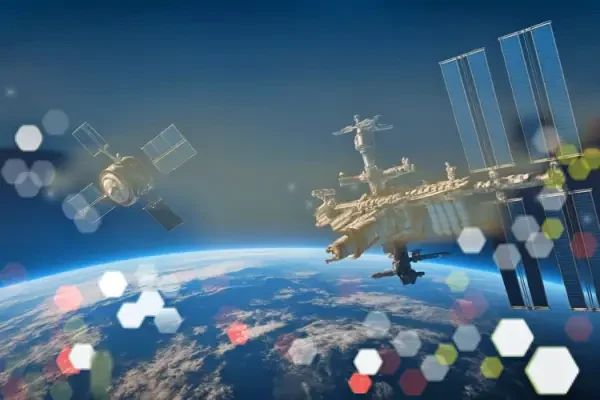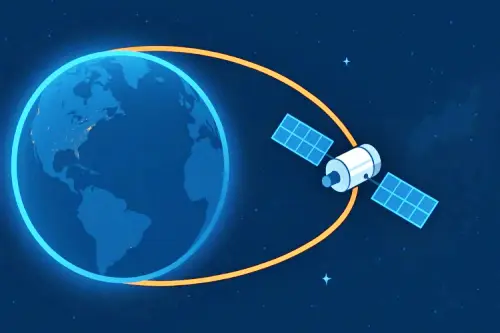Satellites. Look up into the vast, clear darkness of the night sky, and you might catch a glimpse of a silent, steady star gliding gracefully across the constellations.
This is no distant sun, but a marvel of human ingenuity: the International Space Station (ISS) or one of the thousands of satellites tirelessly circling our planet.
To the casual observer, they seem to hang suspended in the void, as if held by an invisible thread, magically exempt from the fundamental laws that govern our world. We know that what goes up must come down.
So why do these billion-dollar instruments and orbiting laboratories, subject to the same gravitational pull as an apple falling from a tree, not come crashing back to Earth?
The answer is both simple and profound, a beautiful paradox of physics: they don’t fall to Earth because they are in a constant state of falling.
They are perpetually plummeting towards our planet, but they do it with such tremendous sideways speed that they continuously “miss” it. This is the essence of an orbit not an escape from gravity, but a masterful harnessing of its power.
Satellites, Newton’s Cannonball and the Art of Missing the Earth.
To truly grasp this concept, we must travel back in time to the mind of Sir Isaac Newton. Long before humanity could launch anything into space.
Newton devised a brilliant thought experiment. Imagine, he proposed, a cannon placed atop the highest mountain on Earth, so high that it pokes above the atmosphere, eliminating air resistance.
If you fire a cannonball with a small amount of gunpowder, it travels a short distance before gravity pulls it to the ground. If you add more gunpowder, the cannonball flies faster and farther before its trajectory curves back to Earth.
Now, Newton reasoned, what if you could fire the cannonball with such an immense, almost unimaginable velocity?
At a specific critical speed, the cannonball would travel so fast horizontally that as it falls vertically, the Earth’s surface would curve away beneath it at the very same rate. The projectile would still be pulled relentlessly towards the planet’s center by gravity, but it would never get any closer.
It would have achieved a perfect, stable orbit a state of perpetual freefall.
The cannonball is forever falling, but it is also perpetually missing its target. This is precisely what happens with the International Space Station.
Orbiting at an altitude of approximately 400 kilometers (about 250 miles), it hurtles through the near-vacuum of space at a staggering speed of 28,000 kilometers per hour (nearly 17,500 miles per hour).
At this velocity, it completes a full circle around our planet every 90 minutes. For every 8 kilometers the ISS travels forward, the Earth’s surface curves downward by about 5 meters. In that same time, gravity pulls the station down by that same 5 meters.
This creates a perfect, delicate equilibrium, a celestial ballet between forward momentum and downward pull.
The Forces at Play.
A Cosmic Tug-of-War.
It’s a common misconception that there is “zero gravity” in space, which is what allows astronauts and objects to float. This is fundamentally incorrect.
At the ISS’s altitude, Earth’s gravitational pull is still about 90% as strong as it is on the surface. The true reason for the apparent weightlessness is the state of freefall itself.
Imagine you are in an elevator and its cable suddenly snaps. For the few terrifying seconds before it hits the ground, you, the elevator car, and any objects inside it would all be falling together at the same rate.
Relative to the elevator, you would be floating. This is precisely the environment on the ISS. The station, the astronauts, and all their equipment are continuously falling together around the Earth, creating a constant state of microgravity.
The two critical forces that define an orbit are.
1. Gravity: This is the constant, unyielding force that pulls the satellite toward the center of the Earth. Without it, the satellite would obey Newton’s first law of motion an object in motion stays in motion and fly off in a straight line into the cold depths of space.
Gravity acts as a celestial leash, or a centripetal force, constantly tugging the satellite inward and bending its straight path into a curve.
2. Inertia and Velocity: This is the satellite’s tendency to continue moving forward at its current speed. While gravity tries to pull it down, the satellite’s immense tangential (sideways) velocity ensures it keeps moving forward.
The balance is not between an “upward” and a “downward” force, but between the gravitational pull bending the trajectory and the forward velocity that seeks to maintain a straight line.
If the satellite’s speed were to decrease, gravity would win the tug-of-war, and its orbit would decay, pulling it closer to Earth. If its speed were to magically increase significantly, its inertia would overpower gravity, and it would spiral outwards into a higher orbit or even escape Earth’s gravitational influence altogether.
A Universe of Orbits.
Not One Size Fits All.
Satellites operate at a wide range of altitudes, each carefully chosen for its specific mission. The required orbital speed is directly related to the altitude—the closer to Earth, the stronger the gravitational pull, and thus the faster the satellite must travel to avoid falling.
• Low Earth Orbit (LEO): Ranging from about 160 to 2,000 kilometers, this is where the ISS, the Hubble Space Telescope, and many Earth observation and reconnaissance satellites reside. The proximity allows for high-resolution imagery and minimal signal delay.
However, this region is not a perfect vacuum. There are still wisps of atmosphere that create a tiny but persistent drag on objects, like air resistance against a moving car. This drag gradually saps a satellite’s speed. To counteract this orbital decay, the ISS must periodically receive a “reboost” from the thrusters of visiting cargo spacecraft, pushing it back up to its target altitude.
• Medium Earth Orbit (MEO): At an altitude of around 20,000 kilometers, you will find the constellations of navigation satellites, including the American GPS, Russian GLONASS, and European Galileo systems.
Here, gravity is weaker, so the required orbital velocity is lower. Their 12-hour orbital period means they move across the sky more slowly, and a network of them can provide continuous global coverage.
• Geostationary Orbit (GEO): This is a truly special and highly valuable orbit located at a precise altitude of 35,786 kilometers (22,236 miles) directly over the Earth’s equator. At this specific height, a satellite’s orbital period is exactly 24 hours—the same as Earth’s rotation.
The result is that the satellite appears to be fixed in a single point in the sky from the ground. This is indispensable for telecommunications and broadcasting satellites (like those for satellite TV) and for weather satellites that need to constantly monitor the same region.
The Inevitable End.
What Happens When a Satellite Stops?
What would happen if a satellite in orbit suddenly lost all its forward velocity? Without the speed to “miss” the Earth, gravity would take over completely. The satellite would begin a true, direct fall, accelerating towards the atmosphere.
As it entered the denser layers of air, the immense speed would cause the air in front of it to compress and heat up to thousands of degrees. This friction and compression would tear the satellite apart and incinerate most of it in a fiery streak across the sky, much like a natural meteor.
This very process is used to dispose of most old or defunct satellites in LEO. To prevent the accumulation of hazardous “space junk,” mission controllers use a satellite’s last reserves of fuel to perform a “deorbit burn.”
By firing its thrusters against its direction of travel, they deliberately slow it down, causing its orbit to decay rapidly and ensuring it re-enters the atmosphere over a remote, uninhabited area, typically the South Pacific Ocean Uninhabited Area, aptly nicknamed the “Spacecraft Cemetery.”
In conclusion, the ISS and satellites are not defying physics; they are a perfect demonstration of its principles. They are engaged in a perpetual dance with Earth’s gravity, a delicate balance of speed and attraction that turns a relentless fall into a stable, predictable journey.
It is a testament to human understanding that we have learned not to fight gravity, but to use it as a tool, allowing our technological eyes and ears to forever circle the globe in a state of controlled, unending descent.
Have a Great Day!



